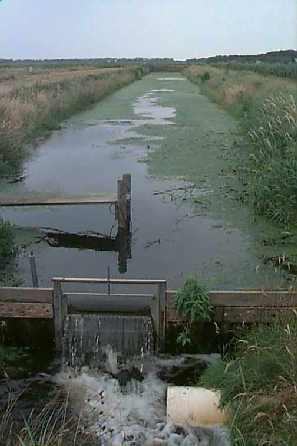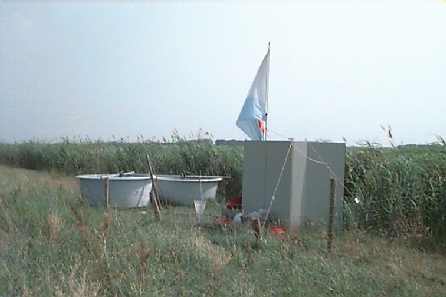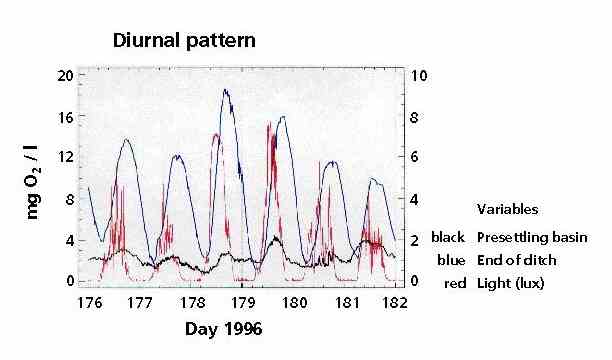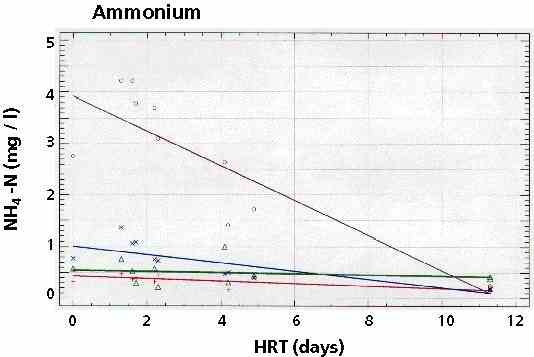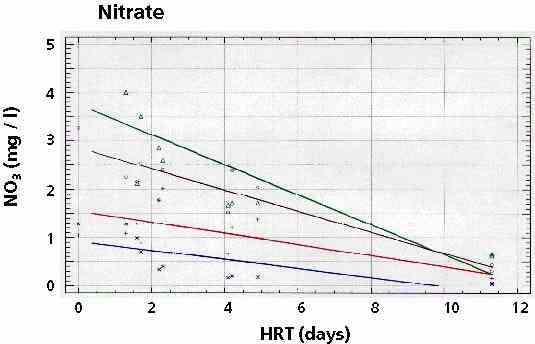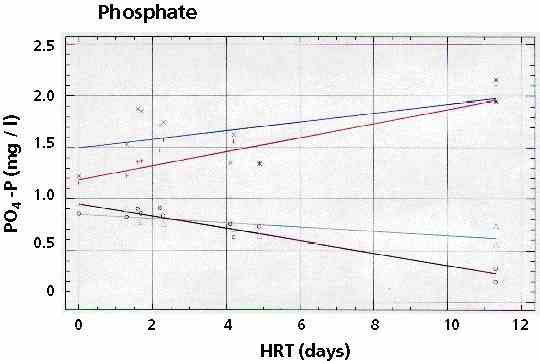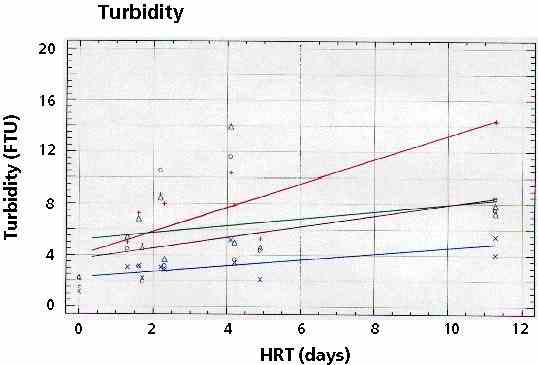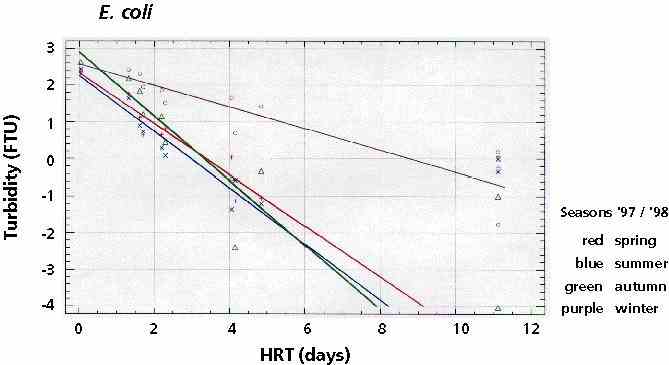From sewage to (re)usable surface water
The use of a full-scale constructed wetland to improve the quality of
the effluent from an oxidation ditch in The Netherlands
Paper for the International
Conference on Environment and Agriculture,
Nov. 1-3, 1998, Kathmandu, Nepal
The Nepali Hymn
some pictures
R. Kampf1, M. Schreijer1, S. Toet2,
J.T.A. Verhoeven2, R.G. Jak3 and M. Groot3
1 Waterboard
Uitwaterende Sluizen in Hollands Noorderkwartier, P.O. Box 15, 1135 ZH Edam
2
Institute of
Ecology and Evolutionary Biology, Utrecht University, P.O. Box 800.84, 3508 TB Utrecht
3
TNO, Department for
Ecological Risk Studies, P.O. Box 57, 1780 AB Den Helder
Summary
The island of Texel in the western part of the Dutch Wadden Sea in north-western Europe
is short of fresh water. Drinking water is transported through a pipeline from the
mainland. The five sewage treatment plants on the island discharge to a relatively small
body of surface water. This necessitated a higher quality of the effluents. Therefore,
after preliminary tests on pilot scale, the waterboard has constructed a full-scale
wetland system to improve the quality of the 3500-m³/day effluent from the sewage
treatment plant Everstekoog.
The constructed wetland is a combination of a pond and ditches, with helophytes and
submerged aquatic plants. After passing a presettling basin, the water flows through nine
parallel ditches with a length of 150 m. The first half of each ditch is only 0.2 m deep
and has vegetation with reed (Phragmites australis) or cattail (Typha latifolia).
The deeper (0.5 m) part contains submerged aquatic plants. One ditch serves as a control
without vegetation. The total surface of the pond and ditches is 1.3 ha, which corresponds
with 0.5 – 1 m2 per population equivalent.
The total hydraulic retention time (HRT) of the whole system was just over two days. In
the second part of the project, the ditches had different HRT´s: between 0.3 and 10 days.
The specific costs are US $ 0.02 – 0.10 per m3 treated water depending
on the price of land and the HRT. These costs are low compared with techniques as
disinfection with UV, sand filtration and other tertiary treatment steps. The energy
requirement of the wetland system is very low; the process "runs on solar
energy".
The constructed wetland acts as a buffer area between the sewage treatment plant and
the surface water. It fits well in the Dutch polder landscape. The main result is that the
treated sewage is converted to a different kind of water, without activated sludge flocs
from the aeration tank. The odour has disappeared. The most important indication for
improvement of the water quality is the diurnal change in oxygen concentration. In the
compartment with submerged plants, it becomes low at night, but very high, up to 20-30
mg/l, during daytime. The water starts to "live"; it becomes more like a natural
surface water. Nitrification and denitrification depend very much on the hydraulic
retention time. At longer HRT´s, we have found a substantial N-removal. In addition,
disinfection is important in the constructed wetland. E.coli-levels were under 10/ml for
most of the time in 1995-1996, and around 1 per ml at the longer HRT´s in 1997.
The research project taught us, that we should consider treated sewage as a source of
good clear water suitable for various applications, instead of a burden. The origin of
sewage is clean drinking water and rainwater. After converting the bulk of the pollutants
into sludge, the effluent is clear water with a high potential for further use, because of
its mineral content. Despite the high levels of nutrients, the water in the presettling
basin in the wetland system remains clear. The level of chlorophyll-a stays well under 10
mg/l for most of the time, probably because of grazing by the usually high numbers of
Daphnia magna. During the summer of 1998 tests were carried out, together with TNO, in
order to understand more about the system and its processes. One of the goals is to use
the nutrients in the effluent of the oxidation ditch to "produce" Daphnia to
improve the food situation on Texel for fish and subsequently birds; like Spoonbills,
which feed on small zooplanktivorous fish.
Introduction
The waterboard "Uitwaterende Sluizen" operates over twenty sewage treatment
plants (STP’s) in the north-west of the Netherlands. Five of them are located on the
island of Texel (Figure 1). Since the early 1970’s the policy of the water board has
been to keep the (fresh) effluent inside the surface water system of the island, rather
than discharge it into the North Sea (Wadden Sea), because of the shortage of fresh water
on the island in summer. The discharge of the effluent into the surface water on the
island causes however particular problems, because of:
- The surface waters on Texel have a characteristic and diverse flora and fauna. Therefore
more attention on the quality of the treated wastewater is needed;
- The volume of waterbodies on the island that receive the cleaned effluent is small. Any
residual pollution in the effluent will hardly be diluted.
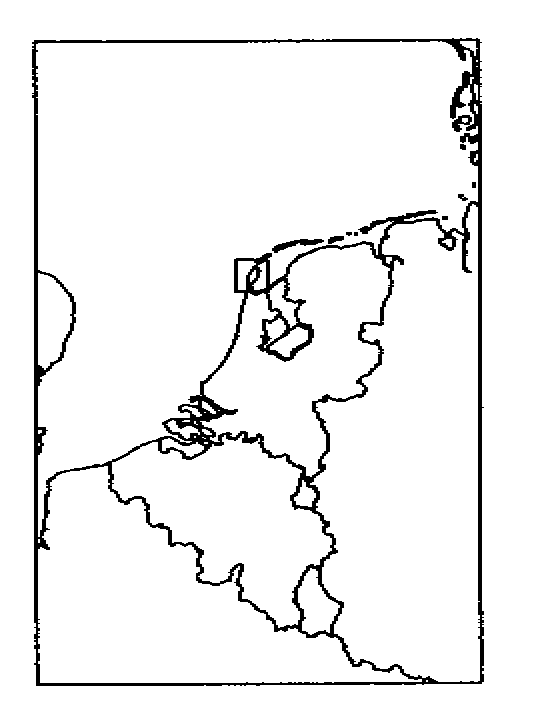
|
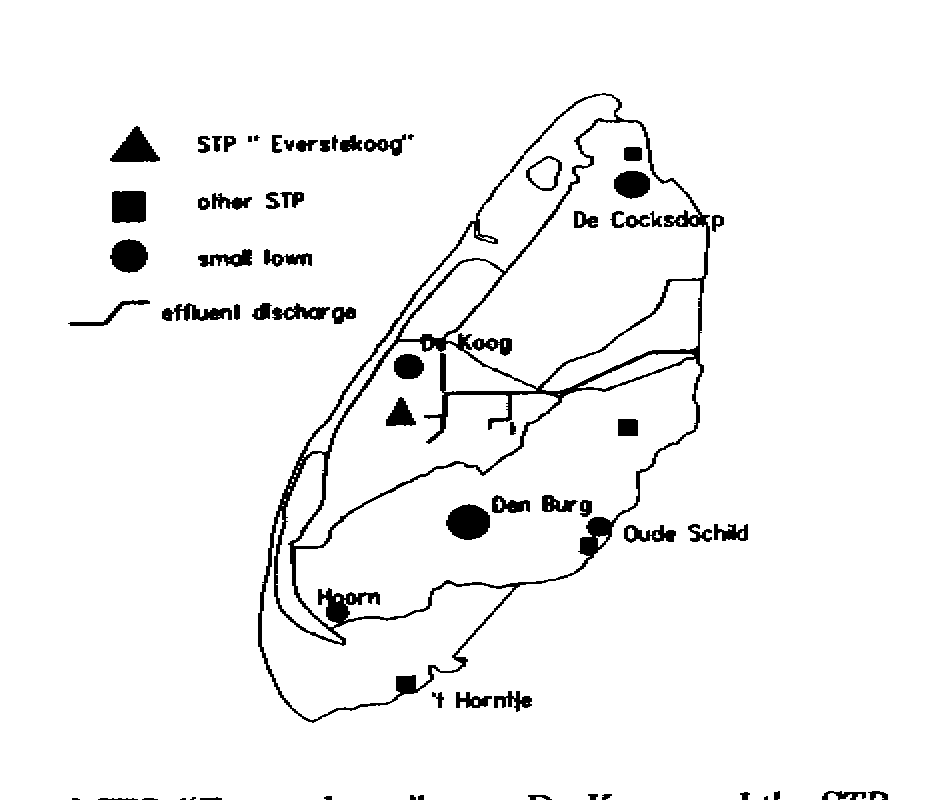
|
| Figure 1 The
island of Texel in the Netherlands and the locations of STP "Everstekoog" near
De Koog and the STP and the fishladder near De Cocksdorp |
On Texel, a great variety of water types exists. From west to east, a salinity gradient
in the surface waters results in many differences in plant and animal life. During summer,
water losses from the surface through evaporation are replenished with groundwater,
rainwater and effluent. The latter source can be substantial: in dry years up to 90% of
the water in the surface water system is effluent. Drinking water is transported to the
island through a main pipe, is the only external supply of fresh water.
During the last decades water treatment in the Netherlands has evolved to a high
standard. From an ecological point of view however, the treated water is still
"dead" water. Originally it is beautiful water; it has been rainwater and
potable water. The bulk of the water is only used for rinsing and as a transport medium.
In an activated sludge plant, the treatment process is a biological process, but it only
involves organisms, common in a polluted environment. The result is an effluent with a
rather low content of organics (most of the carbon pollutants have been converted in
sludge) and a high level of minerals and nutrients. Most effluents in the Netherlands are
very clear, with only a yellowish colour. Normally the levels of suspended solids are low,
below 5 mg/l. Only after heavy rains it can contain up to 1000 mg sludge/l . This sludge
can have a considerable impact near the discharge point. The sludge particles contain high
numbers of human bacteria and viruses. Per population equivalent sewage contains 1010
to 1011 E.Coli per day: or about 108 to 109 per ml. After
biological treatment, the numbers diminish to 103-104 per ml. This
make effluent unsuitable for swimming. Further odour (effluent smells), foam on the water
surface and the sludge particles in the water may negatively effect the aquatic ecosystem
receiving the effluent. Ideally, effluent quality should be as close as possible to that
of the receiving surface water.
Many technological solutions exist to improve the quality of treated wastewater, for
example sand filtration and membrane filtration. These processes are expensive, and above
all the water is still not a "living water". We have been looking for a system
between the treatment plant and the surface water to improve the "ecological"
water quality. The basic idea is pictured in figure 2.
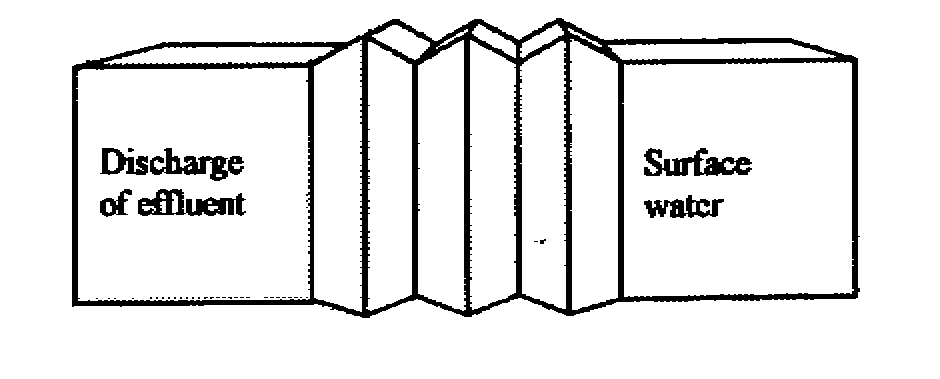
|
| Figure 2 A buffer between the sewage plant and the
surface water (based on [Claassen, in Klapwijk, 1996]) |
This model uses a "buffer" between the sewage treatment plant and the
surface water. In this "buffer" the different fields of engineering and ecology
meet each other to improve the quality of the STP effluent into more natural
"living" surface water.
For Texel, a constructed wetland has been chosen to fulfil this task. The results of
the pilot study of a constructed wetland treating 240 m³/d effluent from the Everstekoog
STP on Texel from 1988 through 1992 has been described by Schreijer et al [in Haberl,
1997]. The positive results of this test have led to a full-scale constructed wetland to
convert the effluent from the Everstekoog oxidation ditch into a more natural "living
water". Some of the considerations were:
- The constructed wetland is a simple system like the oxidation ditch;
- It runs on solar energy "like surface water";
- There is enough space available;
- It fits in the rural Dutch landscape.
The four-year research project was a demonstration of the possibilities of a full-scale
surface flow constructed wetland after an oxidation ditch. It should provide knowledge of:
- The separate processes in the constructed wetland;
- Give insight in maintenance, control and costs of the system. Does the combination with
the constructed wetland lead to savings in the STP, for instance in the construction of
settling tanks because the sludge will be retarded in the wetland or in
nitrification/denitrification?;
- Is it a stable system, also in winter time or at high flows during rain?
This summer the field work of the Everstekoog project has been followed up by
exploratory research to test whether the effluent could be used as a source of water to
"produce" biomass in order to improve the food situation of fish and birds,
especially Spoonbills, on the island of Texel in near future.
The Everstekoog sewage treatment plant
The sewage treatment plant Everstekoog is an oxidation ditch with a load of 45.000 p.e.
in summer. The dry weather flow is 3000-4000 m³/day, the maximum flow is 10.000 m³/day.
Phosphorus removal takes place simultaneously with FeSO4.
The Everstekoog constructed wetland
The constructed wetland is a surface flow system constructed in 1994. The system
consists of a presettling basin, nine parallel ditches with a length of 150 m and a
discharge ditch. The first part of each ditch is only 0.2 m deep and has a vegetation with
reed (Phragmites australis) or cattail (Typha latifolia). The deeper (0.5 m)
part is planted with submerged aquatic plants. One ditch is a control without plants
(Figure 3 and Figure 4). The total volume is 7140 m³ (Table 1). The mean hydraulic
retention time (HRT) is 2.1 day at dry weather flow. In the first research period
(1995-1996) all ditches received the same flow, in 1997/1998 four different flows through
the ditches resulted in HRT´s of 1.6 up to 11.3 days (the retention time in the ditches
alone were 0.3, 1, 3 and 10 days).
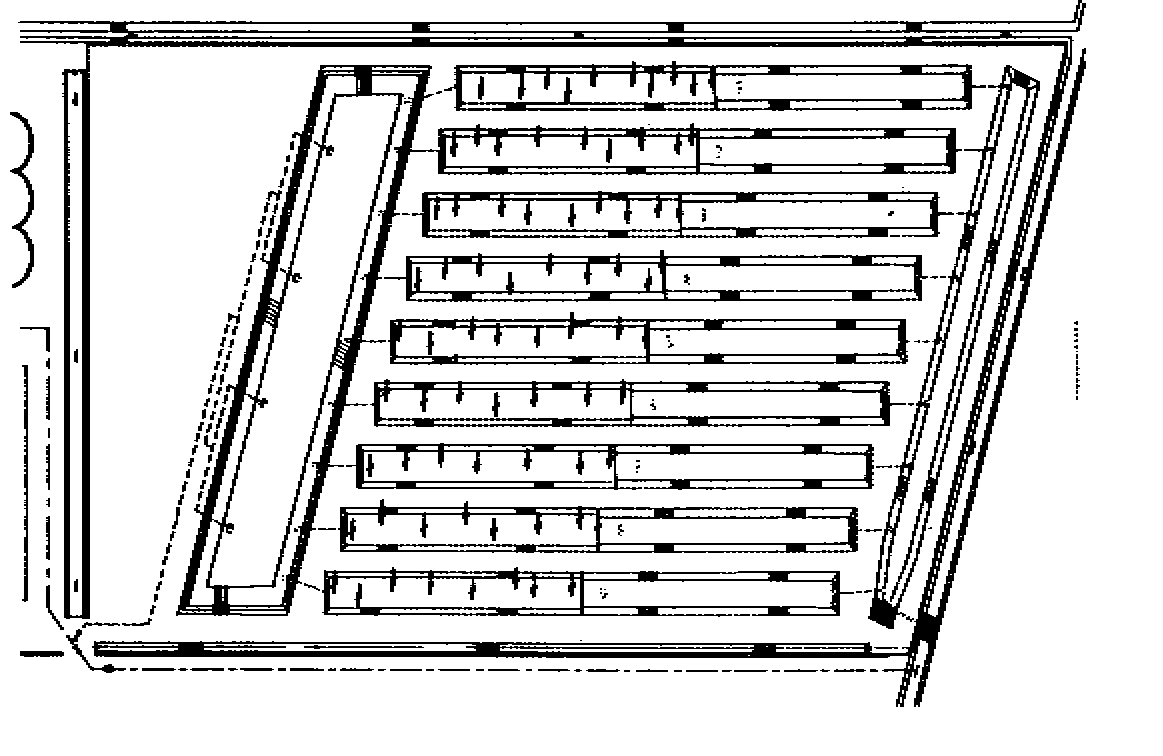 |
| Figure 3 The Everstekoog
constructed wetland |
 |
| Figure 4 Scheme of the
Everstekoog constructed wetland |
Table 1 Dimensions of the constructed wetland
| |
Surface area (m²) |
Volume (m³) |
HRT at dry weather flow
(days) |
| Presettling basin |
3480 |
4400 |
1.3 |
| 9 ditches |
Each 980 |
2360 |
0.7
(0.3 - 10) |
| Discharge ditch |
830 |
3370 |
0.1 |
| total |
13110 |
7140 |
2.1 |
Natural values of the constructed
wetland
Constructed wetlands can have considerable values for aquatic birds (Knight, in Haberl
1997). Though the constructed wetland is situated in the agricultural part of the island,
it attracts quite high numbers of birds. Spoonbills (Platalea leucorodia) come to
feed on small fish. Table 2 contains the number of breeding birds in the wetland in 1997.
Table 2 Breeding birds in the constructed wetland in 1997
| Bird species |
Number |
| Tufted Duck |
Aytha fuligula |
4 |
| Northern Shoveler |
Anas clypeata |
3 |
| Mallard |
Anas platyrynchos |
9 |
| Gadwall |
Anas strepera |
2 |
| Common Gull |
Larus canus |
1 |
| Oystercatcher |
Haematopus ostralegus |
2 |
| Redshank |
Tringa totanus |
1 |
| Eurasian Coot |
Fulica atra |
3 |
| Moorhen |
Gallinula chloropus |
2 |
| Yellow wagtail |
Motacilla flava |
1 |
| Reed Warbler |
Acrocephalus scirpaceus |
12 |
Monitoring and research programme
Pressure sensors in the presettling basin, the ditches and the discharge ditch measured
the flows through the wetland. The instrumentation also included nine oxygen probes with
thermometers, two redox sensors and a weather station. The results of the continuous
measurements (15 minute averages) of water levels, oxygen concentration, temperature, wind
speed and direction, precipitation and light intensity were stored in data loggers and
transferred automatically to the Edam office.
Some aspects of the monitoring and research programme are:
- fortnightly routine water analyses (suspended solids, N, P, macro-ions and faecal
coliforms);
- study of the contribution of the separate compartments on nutrient removal:
- storage in helophytes and periphyton;
- microbial conversions (nitrification/denitrification);
- accumulation in the soil (sedimentation, adsorption and precipitation processes);
- compilation of water and mass balances.
The preliminary test programme, carried out this summer to assess the possibilities to
"produce Daphnia" has been carried at TNO, Department for Ecological Risk
Studies by a student from the Vrije Universiteit van Amsterdam (VUA). Her work included
laboratory and field studies at the Everstekoog plant for measuring growth of algae,
Daphnia, food chain and toxicity studies.
Results
Effluent quality of the STP Everstekoog
The quality of the effluent of the STP Everstekoog is typical for a well functioning
oxidation ditch (very low loaded activated sludge plant), results of 1997 - 1998 are
summarised in table 3.
Table 3 Effluent quality of STP Everstekoog (1997-1998)
| Parameter |
Mean
Concentration |
Standard deviation
N >=22 |
| NO3-N (mg/l) |
2.6 |
2.5 |
| NH4-N (mg/l) |
1.1 |
1.6 |
| Total N (mg/l) |
6.2 |
4.3 |
| Total P (mg/l) |
1.1 |
0.7 |
| COD (mg O2/l) |
32 |
6 |
| E.Coli (number per ml) |
590 |
730 |
A change in water quality
After treatment in the oxidation ditch, the sewage already has a much better quality.
Sewage is grey, smelly. Effluent has become clear water, but still with an odour. Despite
the removal of particles in the settling tank, the effluent still contains fine activated
sludge particles, with a variety of bacteria. Already in the presettling basin in the
constructed wetland the water starts to "live", it is going to resemble
euthrophic surface water. It becomes a home for water life; regularly the water turns red
because high numbers of waterfleas (mainly Daphnia magna). See also the recent
publication in Water Research, describing growth tests of Daphnia in diary waste
stabilization ponds (Kennedy, 1998). The number of different species of plants and animals
in the wetland grew each year. The presettling basin also plays a role at storm water
flows to catch the sludge losses from the STP.
It is difficult to quantify the changes in water quality. The suspended solid content
of the effluent from the wetland is higher then of the STP effluent, but it is a different
kind of suspended solids. In stead of activated sludge flocs the water contains algae,
Daphnia and rests of water plants.
Diurnal oxygen pattern
A first sign in the change of water quality is the diurnal oxygen fluctuation. (Figure
5). The oxygen level in the effluent of the oxidation ditch is
stable and low, in the presettling basin the oxygen level is around 3 mg/l. In the part of
the ditches with submerged aquatic plants the daily oxygen pattern starts to resemble the
pattern of a normal surface water. During the daytime, the submerged aquatic plants and
algae produce such an amount of oxygen that the levels do rise well above the saturation
value. In the afternoon, the high oxygen levels will help the oxygen to penetrate deeper
into the sediment. At the end of the day the oxygen levels drop sharply (Figure 6). On
sunny days (nr. 178 and 179) the oxygen maxima are higher than on less sunny days (e.g.
day 177) This "solar energy process" is also stable during longer periods.
During the summer of 1997 the submerged water plants became covered by Duckweed (Lemna
spp.) and floating algae. (Figure 7). During the summer, the oxygen production came to
a complete stand still, but after the removal of the Lemna in the end of August the
production started again quite quickly.
A more detailed description of the pictures can be found on another page:
Click
to follow the link
N and P removal
At the rather high loading in the first part of the project (HRT just over 2 days,
hydraulic loading around 25 cm/day) both the nitrogen and the phosphorus removal were
rather low. This occurred partly because of the already low levels in the effluent of the
oxidation ditch. In the summer of 1996 NH4 was were removed with 20 %, both NO3
and PO4 with 50 %. Other periods gave a negative P-removal through release from
sediments and dying plant material. Even at low temperatures in the winter of 1995-96 the
constructed wetland lowered the, temporarily, high level of 30 mg NH4/l to 10
mg NH4-N/l.
During the second part of the research program the ditches had different hydraulic
retention times, the total HRT varied from 1.6 to 11.3 days. The HRT had a clear effect on
both N and P removal (Figure 8, Figure 9 and Figure 10)
The literature figures for removal of P and N through harvesting of biomass vary. On an
average the removal through standing crop, incl. the litter will be around 125 kg
N/ha.year (63-220) and 15 kg P per ha/year (3-19) in the Netherlands [Toet, 1995]. This
project will give more accurate figures as soon as the data are analysed. The load of N
and P with the STP effluent to the constructed wetland is around 6800 kg N/year and 800 kg
P/year. Denitrification is probably the most important pathway for N-removal. In general,
denitrification in periphyton shoots of submerged helophytes was much higher than in the
soil, due to diffusion limitation in the soil top layer.
| Effect
of Hydraulic Retention Time: The results of the last research year (1997-98) are
presented in figures 8 -12 with four regression lines for different seasons: spring,
summer, autumn and winter. The analyses of the results pointed out that there were
profound differences in results between these seasons. Some of the differences were
conform our expectations (E.Coli),while others were rather surprising (phosphate and
turbidity).
Bigger pictures are on another page:
Click
to follow the link |
Disinfection
Already the pilot-study in a small ditch like constructed wetland [Schreijer et al
1996] proved that the combination of ponds and helophytes was effective for disinfection
of the effluent of the oxidation ditch.
In this pilot study the relation between E.Coli: (numbers per ml) and the hydraulic
retention time (days) was10log E.Coli = -0.65*time + C. Table 4 gives the k-values in the
different seasons during the last research year 1997/1998. Possibly, due to wildlife in
the system, the E.Coli numbers were rarely below 1 per ml. For E.Coli values of less then
10/ml throughout the year, the HRT must be at least 4 days. For only disinfection to a
level of E.coli 10/l , a HRT of 2 days will be sufficient. Two of the ditches had the same
retention time (HRT of the complete system 2.1 days) during the whole research period:
Figure 13. To minimise the influence of storm water flows it is important to buffer as
much water in the system as possible, for a surface flow system this can be done by means
of a clever design of the weirs.
Table 4 The E.Coli removal rates in the different seasons
in 1997-1998
| Season |
k-value |
Correlation coefficient |
| Spring |
-0.69 |
-0.95 |
| Summer |
-0.76 |
-0.96 |
| Autumn |
-0.87 |
-0.88 |
| Winter |
-0.29 |
-0.91 |
|
| Figure 13 E.Coli in the
effluent of the oxidation ditch, the presettling basin and the effluent of the constructed
wetland at an HRT of just over two days over a period of three years |
Suspended solids in the effluent of the wetland
One of the surprises in this research project is the augmentation of the turbidity of
the water, especially at higher hydraulic retention times (Figure 11). An important
feature of the presettling basin is that it acts as a buffer when during storm water flows
the STP effluent contain high contents of dry solids. Retaining these high peaks in
discharge of sludge will lead to savings in settling tanks.
Costs
The investment costs of the constructed wetland alone were less than US $ 250.000,
excl. the extensive instrumentation for the research project. This leads to capital costs
of US $ 25.000 per year. Maintenance and supervision costs are about US $ 25.000 per year.
At a flow of 1.200.000 m³/year the specific cost are about US $ 0.05 per m3 at
an HRT of 2 days and US $ 0.10 at a HRT of 4 days. To put this in perspective the costs to
transport the waste water to the STP are estimated at US $ 0.10 per m³ and of the
treatment of the waste water in the oxidation ditch, including sludge treatment US $
0.50/m³.
Conclusions on the 4-year research
project
The constructed wetland increased the water quality of the effluent from an oxidation
ditch:
- The oxygen regime improved, the effluent became a clear diurnal pattern of oxygen as
long as the sunlight can reach the submerged plants. This pattern also existed even in
wintertime at low temperatures;
- The hydraulic retention time has a distinct effect on the fate the output of the
wetland. Especially the removal of ammonium, nitrate and E.Coli becomes effective at
longer HRT´s even in wintertime. The turbidly increases at longer HRT´s due to the
production of biomass in the wetland.
An HRT of two days is sufficient for a reliant disinfection in summer, at a HRT of
around 4 days the disinfection is also effective in wintertime. At this HRT, also a
substantial removal of nitrogen has been found. A stable P-removal in all seasons needs
either a much longer retention time or, in most cases more practical, chemical
precipitation.
Further developments: Growing algae and daphnia
on effluent
The Everstekoog constructed wetland proves the values and the possibilities of a simple
semi-natural/constructed ecosystem for the improvement of effluents from sewage treatment
plants. Currently the waterboard "Uitwaterende Sluizen" is studying for which of
the other plants of the waterboard constructed wetland for this purpose is feasible.
Another waterboard in the Netherlands, De Maaskant, is constructing an
"Everstekoog" type wetland with a capacity of 35.000 m³/day.
An application of this type of wetland we are studying currently, is the combination of
the discharge of polished effluent and a fish ladder. Near the STP De Cocksdorp, a siphon fish ladder has
been constructed. Due to the high dikes, fish like Three Spined Stickelback (Gasterosteus
acculeatus) and Eel (Anguila anguila) can not reach the fresh surface waters of
the island anymore. To lure the fish to the fish ladder a flow of 350 m³/day fresh water
is pumped in to the North Sea. When enough fish has gathered, the fish is transported by
means of a siphon over the top of the dike into the surface waters of the island. A couple
of problems exist:
- During drought the fresh water used for the lure flow is needed by the farmers;
- The STP De Cocksdorp, which is overloaded in summer, discharges its effluent close to
the point where the fish is released.
- The fish ladder therefore functions not as good as possible and the fish’s
spawning-bed will be polluted.
The basic idea is whether a surface constructed wetland can:
- improve the surface water quality near De Cocksdorp and;
- produce a water quality, good enough to be used as lure flow for the fish ladder and;
- be used to grow food for the Three Spined Sticklebacks that arrives on the island
through the fishladder, thus improving the food situation of Spoonbills and other birds on
the island.
This wetland could function as a trapped system where nutrients are
turned into biomass (Figure 14). Algae as a food source for zooplankton will grow on
nutrient rich effluent. The zooplankton is grazing the algae and they serves as a food
source for the Stickleback.

|
| Figure 14 Food dependence
in the wetland model |
An important observation in the "Everstekoog" wetlandsystem
was the massive development of zooplankton in the presettling basin during the summer. The
food source of this zooplankton was unclear because algae had very low numbers in this
basin (<10
mg/l
chlorophyll-a). Therefore the hypothesis was that the zooplankton lived mainly of bacteria
on the so called "pin-point flocs" in the effluent.
During a six-month pilot study, the possibility of using effluent from
a wastewater treatment plant for the improvement of the food situation of Sticklebacks and
Spoonbills was studied. Some pictures of the experiments.
Questions that needed to be answered were:
- Are there restrictions to cultivate algae and zooplankton on effluent due to water
quality problems (e.g. oxygen levels, pH etc.)?
- Is it possible to breed zooplankton on organic matter from the STP (active sludge)?
- Is it possible to maintain a breeding process in a surface flow system on effluent?
- What is the risk of biomagnification of copper and zinc in the food chain from
zooplankton to Spoonbills?
Algae
The growth of Chlorella pyrenoidosa on effluent of STP De
Cocksdorp and STP Everstekoog and OECD was followed for a 20 day period in duplicate
systems. Nutrients were added to avoid nutrient limitation in order to allow for the
assessment of toxic effects.
C. pyrenoidosa is able to grow on effluent, but the growth rate is
lower than in the algal growth medium (OECD) (Figure 15). The inhibition of algal growth
may result from unfavourable water quality conditions. Conclusion is therefore that low
algal numbers in the presettling basin is not only due to grazing.

|

|
| Figure 15
Growth rate of C. pyrenoidosa on effluents (Co = De Cocksdorp, Ev = Everstekoog, + =
nutrients added) and algal growth medium (OECD) |
Figure 16
Numbers of D. magna after 23 days (start 20 ind.) (Medium: Co = De Cocksdorp, Ev =
Everstekoog,) and algal growth medium (OECD) |
Zooplankton
D. magna was cultured on effluents from STP De Cocksdorp, STP
Everstekoog and a growth medium (OECD) to compare its performance (determined by survival
and reproduction).
In most systems D. magna numbers increased (from the initial 20
individuals at the start) as a result of reproduction (Figure 16). Although reproduction
was observed in the effluents, reproduction was hampered in comparison with the standard
medium. Growth on effluent of STP De Cocksdorp was more limited than growth on effluent of
STP Everstekoog.
From an experiment with plankton enclosures (plastic bags) in the
presettling basin, supplied with effluent it appeared that zooplankton grows faster when
the concentration of activated sludge increased. Therefore, it can be concluded that D.
magna is able to grow on sludge particles (activated sludge) in the effluent of the
oxidation ditch.
Phytoplankton and zooplankton in a flow-through system
When it became clear that phytoplankton and zooplankton where able to
grow on effluent, research was done to find out if it was possible to cultivate
phytoplankton and zooplankton in a flow-through system (Figure 17)
In mesocosm I C. pyrenoidosa was cultivated on effluent which
flows to mesocosm II in which D. magna was grazing on C.pyrenoidosa. During
68 days, the density of C. pyrenoidosa and D. magna was followed. This
experiment showed that the number of D. magna could reach a density of 1900 per
litre as long as the concentration of algae in mesocosm I was 40 µg chlorophyll-a/l or
more. In the field situation there was < 10
mg/l. The preliminary conclusion is that in effluent algae are not likely to be a
good foodsource of zooplankton. However, bacteria on the "pin-point floc" in the
effluent are probably a very good alternative.
Biomagnification of copper and zinc in the system
Originally, the effluent consists of rain and drinking water. Because
this water flows through either copper drinking water pipes and zinc gutters, the effluent
may contain higher copper and zinc concentrations. Therefore, biomagnification of copper
and zinc in the system may cause a risk. Both copper and zinc concentrations in Daphnia,
grown in effluent were not higher than usual in Dutch surface water. The risk of
biomagnification of copper and zinc was studied by feeding Three Spined Sticklebacks for a
three week period with zooplankton caught from different locations; the presettling basin,
a field location, and from a culture. After three weeks, the Sticklebacks will be analysed
on copper and zinc concentrations. Results are not available yet.
Preliminary conclusions
- Cultivation of phytoplankton and zooplankton on effluent of STP De Cocksdorp en STP
Everstekoog was possible at suboptimal rates. A difference in growth-rate between the STP
effluents was observed.
- Cultivation of zooplankton on algae in a flow-through system is possible as long as the
algal concentration can be kept above 40 µg chlorophyll-a/L. Zooplankton can be
cultivated on active sludge instead of algae.
Perspectives
A surface flow constructed wetland, like the Everstekoog system, is a simple attractive
system. It is also cheap as long as land costs are not too high. It looks like a Dutch
polder landscape; the maintenance of the system resembles the maintenance of our ditches
and canals. Near populated areas one of the features of the constructed wetland is that it
can be combined with recreation areas and wildlife.
A combination of open ponds, helophytes and submerged aquatic plants is a
cost-effective way to change sewage in to a "living" water suitable for various
purposes. The use of the minerals in effluent of STP´s to "produce food" to
improve the food situation on Texel of fish and subsequently birds, which feed on small
zooplanktivorous fish, like Spoonbills seems feasible. A trapped ‘food-chain
type’ system seems a promising option to increase the ecological value of effluents
from oxidation ditches.
Literature
Borowitzka, M.A.; Borowitzka, L.J. (Eds.) (1988):
Micro-algal biotechnology. ISBN 0 521 32349 5 ed. Cambridge University Press, Cambridge.
477 pages.
Haberl, R.; Perfler, R.; Laber, J.; Cooper, P. (1997):
5th International Conference on Wetland Systems for Waterpollution Control, Vienna,
September 1996. Water Science and Technology 35(5), 347. (IAWQ, IWGA; Austria)
IAWQ (1998): 6th International Conference on Wetland
Systems for Water Pollution Control, Aguas de San Pedro, Brazil, September 27 to October
2, 1998. IAWQ conference.
Kadlec, R. H. ; Knight,RL (1995): Treatment Wetlands.
CRC Press Inc, Boca Raton, Florida. 893 pages.
Kampf, R.; Toet, S.; Schreijer, M.; Verhoeven, J.T.A.;
Logtesteijn, R. van (1996): A constructed wetland system to improve the effluent quality
from an oxidationditch. In: Poster in Proceedings 5th International Conference on Wetland
Systems for Water Pollution Control, Austria, 1996. IAWQ
Kampf, R.; Toet, S.; Schreijer, M.; Logtesteijn, R.
van; Verhoeven, J.T.A. (1998): A constructed wetland system to improve the effluent
quality from an oxidation ditch. poster Waterboard Uitwaterende Sluizen and Utrecht
University, this conference.
Kemper, J.H (1995): Role of the Three Spined
Stickelback (Gasterosteus acculeatus L.) in the food ecology of the Spoonbill (Platalea
Leucorodia), Behaviour 132, 15/16
Kennedy, F.R., (1998). Growth potential of daphnia
magna straus in the water of diary waste stabilization ponds. Wat. Res. Vol. 32, No. 4,
pp. 1325-1328.
Klapwijk, S. (Ed.) (1996): 25 jaar toegepast onderzoek
waterbeheer, jubileumsymposium STOWA, September 1996. STOWA, Utrecht. 212 pages.
Schreijer, M.; Kampf, R.; Toet, S.; Verhoeven, J.T.A.
(1996): The use of constructed wetlands to upgrade treated effluents before discharge to
natural surface waters in Texel island, The Netherlands - pilot study. 5th International
Conference on Wetland Systems for Water Pollution Control ed. IAWQ, Austria.
Toet, S. (1995): De invloed van Pragmites australis op
de zuivering van (afval)water. Scriptie Landschapsoecologie ed. Universiteit Utrecht,
Utrecht. 37 pages.
Toet, S.; Huibers, L.; Offerman, S.; Logtestijn, R.
van; Schreijer, M.; Kampf, R.; Verhoeven, J.T.A. (1998): Denitrification in soil,
periphyton and water of a surface-flow wetland system used for polishing tertiary treated
wastewater. Presentation at the 6th International Conference on Wetland Systems for Water
Pollution Control, IAWQ, Brazil, IAWQ
Vymazal, J.; Brix, H.; Cooper, P.F.; Green, M.B.;
Haberl, R. (Eds.) (1998): Constructed wetlands for wastewater treatment in Europe. ISBN
90-73348-72-2 ed. Backhuys Publisher, Leiden, The Netherlands
Wintermans, G.J.M. (1997): De hevelvispassage op Texel,
effecten op visfauna en lepelaars in de sloten van de polder Eijerland (eindrapportage
biologische monitoring). WEB-rapport 97-4 ed. Wintermans Ecologen Bureau, Texel.
to contact us please address either of the
authors by mail or :
by Email to Ruud Kampf
wabrk@ushn.nl
to the homepage of Ruud Kampf
last changes: 18-01-02

